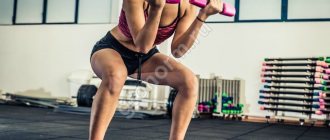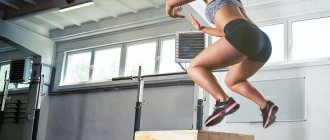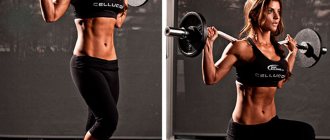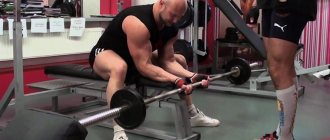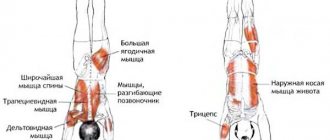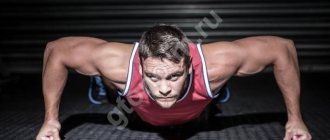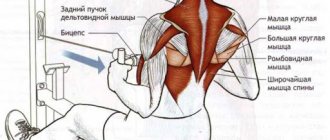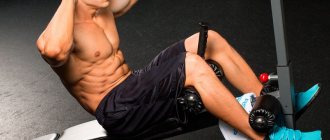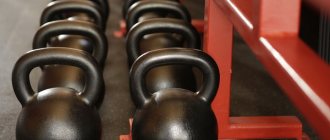The benefits and harms of good morning exercises
The undeniable benefits for a healthy person are as follows:
- The exercise creates toned and voluminous gluteal muscles by stretching them and engaging them in work without a large number of synergistic muscles.
- Bending eliminates the work of the quadriceps completely and involves the hamstrings to a lesser extent.
- Good morning strengthens the muscles of the lumbar spine, which are responsible for stabilizing the back and beautiful posture.
- There is a seated version of the exercise that completely eliminates the work of the hips.
- Good morning exercises generally strengthen the muscles in the back of your body and make them more flexible.
The exercise can cause harm if: Improper technique is performed, in which the muscles do not fix the spine and rounding of the lumbar and thoracic region is formed, which injures the spine and leads to back pain.
Description of the exercise
A very good exercise, but very dangerous if used carelessly. We bend over almost parallel to the floor, bending our legs slightly. Let's look straight. If you look at the floor below you, you will hunch over.
This exercise can also be performed with dumbbells. Hold a dumbbell behind your back, between your shoulder blades along your spine. Or with a disc from a barbell. With these options, keeping your back straight is a little easier. Because you involuntarily straighten your shoulders to hold the disc or dumbbell behind your back.
Main features
1. Alternatively, this exercise can also be performed while sitting. This way you can take on more weight. However, the buttocks and hamstrings will work much less. And almost the entire load will fall on your back.
2. The weight should be such that you can do at least 6 repetitions correctly. If you can’t keep your back straight at the bottom point, then put less weight. In general, the weight on inclines should not exceed 50% of the deadlift for one repetition. But that's my personal opinion.
3. If you have back problems (hernia, protrusion, osteochondrosis, or just back pain), then this exercise is contraindicated for you. Since the load on the spine is very large here.
4. Be sure to bend your legs. But don't turn bending into squats. The tilt of the body should be slightly above parallel. Approximately 10 - 15 degrees above parallel. With small weights you can reach parallel to the floor.
5. You need to bend over and rise smoothly. This exercise is not one where you need to make sudden movements.
6. Remember: the less you bend your legs, the more you work your hamstrings. The more you bend your legs, the more your buttocks work (just don’t overdo it).
Technique for performing bends while standing with a barbell on your shoulders
- Place the bar on the top of your trapezius muscle and lift it off the rack using a shoulder-width grip. Take two steps back from the frame. Tuck your shoulder blades toward the center of your back and tighten your abdominal muscles.
- Place your feet hip-width apart, parallel to each other.
- As you inhale, bend your knees and push your pelvis back, placing your body weight on your heels, but do not squat. This increases the stretch of the gluteal muscles and hamstrings. Lower your torso parallel to the floor. Do not round your back when tilted, maintain a natural arch in the lumbar region.
- As you exhale, pushing off with your heels, straighten your torso in a concentrated manner using your gluteal muscles, not your back. Fully straighten your pelvis and knees at the top, curling your tailbone down. Under no circumstances should you leave an excessive arch in your lower back.
What muscles work?
First of all, the muscles of the back of the thigh are involved during the exercise. They work together with the hamstrings to provide knee mobility. Hamstring strength is important for many sports and in everyday life.
Also active are the so-called synergist muscles, which act in conjunction with others. These include the gluteal muscles and the adductor magnus muscle. The glutes are responsible for stretching, rotating, and lateral movement of the hips. The adductor magnus is a small muscle that is also involved in all movements of the hips.
The “Good Morning” is an exercise that also engages the small but very important erector spinal muscles, which not only promotes a strong back, but also healthy posture and proper gait.
Technique for performing bends while sitting with a barbell
This option of bending allows you to minimize the load on the hamstrings, but also requires good mobility of the hip joints. For injuries, pain and inflammation in the hip joints, this option is prohibited.
- Place the bar on the top of the trapeze and hold it tightly in one position without letting it roll down onto your neck.
- Sit on the edge of a bench and place your feet wide apart.
- As you inhale, lower your straight back down as low as possible, as far as the flexibility of your muscles and joints allows. Don't round your back. Feel the stretch in your gluteal muscles.
- As you exhale, straighten your torso using your gluteal muscles and return to the starting position.
Exercise technique
Understanding the technique of performing bend-overs with a barbell on your shoulders is impossible without understanding the anatomy of the lumbosacral region. Relatively speaking, you can bend over by bending the hip joints with the knee fixed, or by bending the lumbar spine, and you can bend at the hip joints and lower back at the same time - as happens when we need to bend as low as possible.
You bend at the waist when you have to lean over something, such as when you wash socks in the bathtub. We can observe flexion in the hip joints with a fixed lower back in the gym when we see an exercise such as deadlifts. So, it is precisely this kind of movement that interests us in the bending exercise with a barbell on the shoulders; the first two described options are absolutely unacceptable, due to the very high risk of injury.
Initial position
- Standing, feet shoulder-width apart, or slightly wider.
- The knees are slightly bent, the support is on the entire foot (maintained throughout the entire movement).
- The lower back is arched and rigidly fixed - it remains in this position throughout the entire exercise.
- The bar rests on the shoulders, the shoulder blades and shoulders are lowered, the grip is arbitrary, depending on anthropometry and mobility in the shoulder joints.
- The gaze is directed upward or in front of you.
Tilts
We bend the hip joints in isolation, thereby leaning forward until we feel a stretch in the gluteal muscles. We fix this feeling, linger at the lowest point for a second or two, straighten the body under control, due to extension in the hip joints. Movements of the pelvis are extremely undesirable; you can often see a technique in which at the top point the athlete straightens the body completely and slightly moves the pelvis forward; this option is incorrect, as it transfers the load from the muscles and tendons to the lumbar vertebrae.
An important point about the weightlifting belt: this accessory disables the muscles of the lower back and abdominals, further disrupting the trophism of these areas due to strong compression of the blood vessels. If you are tasked with loading the gluteal muscles in isolation, sure, a weightlifting belt may make sense, but it would make more sense to use a more appropriate tool for this purpose.
Accordingly, we do not use a belt when bending over with a barbell; our insurance is the gradual development of all muscles involved in the movement, a systematic increase in working weights, and ideal technique.
How to replace the barbell
For those for whom barbells on the shoulders cause discomfort and compression on the spine is contraindicated, there is an excellent option for exercising with a weight plate. To perform it, you should grab the pancake with both hands crosswise and hold it on the chest. But under no circumstances should you round the chest. The technique is the same as with a barbell, but it is safer for the spine, the main thing is to select an adequate load
Recommendations for girls on bending over with a barbell for the buttocks
Girls should use barbell bends if they need the maximum isolated load on the gluteus maximus muscles as possible.
- When performing the technique, direct all attention to the buttocks and concentrate on them while extending the torso, the body weight should remain on the heels. If the load is shifted to the toe of the foot, then the exercise will be performed to a greater extent with the back.
- Don't take a lot of weight, it's not necessary for this exercise, don't force it. Learn to work with lighter weights, honing your technique and feeling how your torso extends solely through the gluteal muscle group.
- To get good results, it is enough to perform 15-25 repetitions in 3-4 sets.
Effect on muscles
The main load when performing bends with a barbell falls on the back muscles, namely the spinal extensors. These muscles run along the entire spinal column, they support the back in the correct position. The gluteus maximus muscles also work (raise the body from an inclination), the hamstrings (participate in raising the body, fix the position of the knees), semitendinosus and semimembranosus muscles.
The exercise uses the muscles of the back, buttocks and back of the thighs.
This exercise is not recommended for beginners. It is well suited for athletes with average and high levels of training.
How to replace the good morning exercise
Also, bending over with a barbell on your shoulders can be replaced with the Romanian deadlift if there is discomfort when holding the barbell on your shoulders. Another option for replacing the exercise is hyperextension.
Romanian deadliftHyperextension
Confusion in concepts
“Women’s and men’s” trainers are very fond of saying that deadlifts are for women. What. They can tell this to Phil Heath, who does this exercise regularly. Or the millions of not-so-famous powerlifters for whom the deadlift is the second auxiliary movement for the biceps hamstrings after the standing bend over with a barbell.
Common people often confuse:
- Deadlift, that is, deadlift with straight legs;
- Deadlift, a competitive powerlifting exercise;
- Romanian deadlift
This exercise is often called a “deadlift” in Russian coaching practice. The term came from English-language translated magazines. In Soviet textbooks on weightlifting, the movement was called “bending over with a barbell in hands”; the “Romanian” deadlift as such was not distinguished there; a similar exercise was called “push deadlift”.
For your convenience, the “Romanian” deadlift is a bent-over exercise with a barbell with slightly bent knees. Bending helps to overcome the dead point and lower the barbell lower. Therefore, contrary to popular belief, the “Romanian” is not an exercise that “isolates the hamstrings and buttocks,” but a movement that shifts part of the load to the lower back. Therefore, in scientifically based training plans, it is performed with light to medium weights, and is not used to set strength records.
The deadlift or straight-legged row is called so precisely because of the locked knees, this movement is more for the hamstrings and buttocks, and less for the lower back. The classic deadlift is different in that the weight is lowered to the floor each time and is lifted off it by pushing off the floor with your feet. It is a mistake to think that the classic deadlift is some kind of hybrid of a squat and deadlift. The angle of bending at the knees may not be large at all; the difference is in the movement, or more precisely, in the vector of application of force. The movement is initiated by pushing the legs into the floor, and always starts with the legs, not the back.
